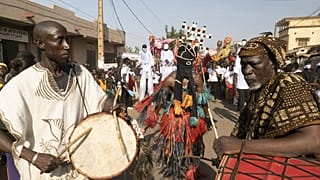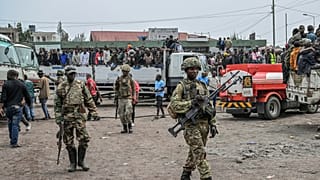Mali
In a room at the Ahmed Baba Institute in Timbuktu, staff photograph and scan fragile manuscripts, page by page.
These texts, some dating back hundreds of years, contain knowledge that scholars say exists nowhere else.
Thirteen years ago, when al-Qaida-connected fighters swept into the city, staff and local families smuggled tens of thousands of manuscripts south to Bamako for safety.
Now, after extensive digitisation, most have been brought home.
Dr Mohamed Diagayaté, general director of the Ahmed Baba Institute, says: "You have a lot of historical information about the area, like the Macina region, Mopti and its surroundings and Timbuktu and its surroundings. So, what we find in these ancients manuscripts cannot be found anywhere else."
In display rooms and storage vaults, manuscripts sit open on tables and shelves.
Some survived fire damage during the 2012 occupation, their edges charred but the writing still visible.
Others remain missing, noted only by labels marking empty spaces.
Among the manuscripts are medical texts, legal rulings, letters, astronomical notes and chronicles of West African empires.
In some pages, scholars debate whether smoking tobacco was moral or forbidden.
In others, officials urge reducing dowries so poorer men could marry.
Marginal notes record earthquakes and local events long forgotten elsewhere.
Sane Chirfi Alpha is the founding member of SAVAMA DCI, which is a local nonprofit organisation dedicated to the safeguarding, preservation, and promotion of the ancient Timbuktu manuscripts.
He says the collection reveals a depth of scholarship that challenges assumptions about the region's past.
"According to old documents, there were doctors here in Timbuktu who performed surgery to treat cataracts. The same manuscript also says that a doctor from Timbuktu saved the French throne. The crown prince was sick, and French doctors could not cure him. It was the doctor from Timbuktu who cured him."
But many manuscripts remain in family libraries across Timbuktu, preserved in traditional wooden chests.
Some families struggle financially, raising concerns about the risk of private sales.
Alpha adds: "The families that hold the manuscripts are in a difficult situation and receive no support. So, when these families have money problems, the father might want to sell the manuscripts."
Inside the institute, staff continue cataloguing, preserving and teaching.
One important tradition still documented in many manuscripts is the chain of teaching, where scholars recorded who taught whom through generations.
Dr Mohamed Diagayaté, general director of the Ahmed Baba Institute says: "When a student finishes studying with a scholar, that scholar gives him a certificate saying he has taught him a subject, which the student has mastered. The certificate also says that the student learned it from a certain scholar, and that this scholar learned it from another scholar, going right back to the person who wrote the original document."
The institute also trains new specialists.
Students review texts on screens and in classrooms, including twenty-four-year-old Baylaly Mahamane.
Mahamane says: "I want to be a manuscript specialist because I think it's a good thing. When I become a manuscript specialist, I will be able to do many things that will benefit me and others. Manuscripts contain lots of information about medicines and explanations of how to use them to treat various illnesses."
Security, however, remains a concern.
Despite the return of the institute’s manuscripts, some researchers are still hesitant to travel north.
Timbuktu lies in a region where armed groups linked to al-Qaida and other factions remain active, and periodic attacks and road blockades have made movement unpredictable.
For many scholars, the journey to the city still carries risks, slowing down research and preservation work that relies on experts being able to reach the manuscripts safely.
Abdoulaye Cissé, general secretary of the institute, says: "Some people are still afraid because they think it's not safe in the north of Mali. This fear often stops them from coming here to do the work they need to do, which is related to the manuscripts."
Beyond the library walls, preparations are underway across Timbuktu for Mawlid al Nabi, the celebration of the Prophet Muhammad’s birth.
Residents hang coloured lights around Sankoré Mosque as Timbuktu prepares for Mawlid al-Nabi, the celebration of the Prophet Muhammad’s birth.
The mosque, once a major centre of Islamic teaching, is a reminder of the city’s long tradition of scholarship.
For many here, the manuscripts belong to that same lineage.
They see the texts as part of the cultural fabric that has shaped Timbuktu for centuries, connecting religious festivals, community life and learning across generations.
As digitisation, conservation and training continue, caretakers say the priority now is to secure this written record of West African history and ensure it remains accessible for the future.













01:04
Some fuel stations, schools reopen in Mali amid jihadist blockade
00:55
Mali foreign minister discusses security situation with U.S. official
01:53
Designer Alphadi returns to Timbuktu with a “Caravan of Peace”
Go to video
Timbuktu marks 700 years of iconic Mosque with community celebration and restoration
01:02
France expels Malian diplomats, ends anti-terror cooperation
01:33
Mali military escorts vehicles after militants attack fuel trucks